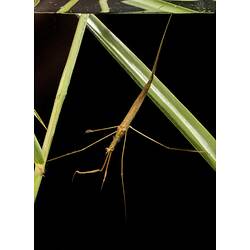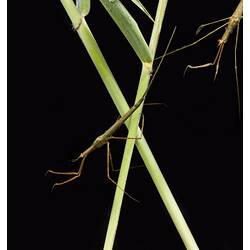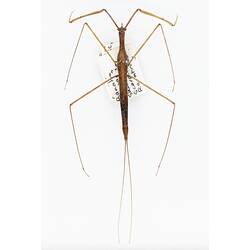General Description
This large elongate insect can easily be identified by the tubular respiratory siphon that it uses to draw air from the surface. The siphon can be one third or more the length of the body. The front legs are like those of a praying mantis (raptorial), where the prey are trapped between the first two segments of the legs. Body length can be approximately 2-5.5 cm, excluding the siphon.
Biology
Water Stick Insects are sit-and-wait predators. They hide in submerged vegetation with their head and front legs hanging downwards. Their respiratory siphon protrudes through the water surface so they can breathe. They can sense vibrations given off by their prey which they grab with their front legs. They eat a variety of aquatic prey, often mosquito larvae and even tadpoles. Eggs are usually laid in slits made by the female in floating plants.
Distribution
Largely in southern Australia from Western Australia to Queensland.
Habitat
Aquatic vegetation along the margin of a water body including swamps, ponds and other slow-moving waters.
More Information
-
Animal Type
-
Animal SubType
-
Brief Id
This distinctive aquatic insect has a long thin cylindrical body with a respiratory siphon at the end of the abdomen and long slender legs.
-
Colours
Brown
-
Maximum Size
5 cm
-
Habitats
-
Diet
Carnivore
-
Endemicity
-
Commercial
No
-
Taxon Name
-
Scientific Author
Montandon, 1903
-
Kingdom
-
Phylum
-
Subphylum
-
Class
-
Order
-
Family
-
Subfamily
-
Genus
-
Species Name
dispar




